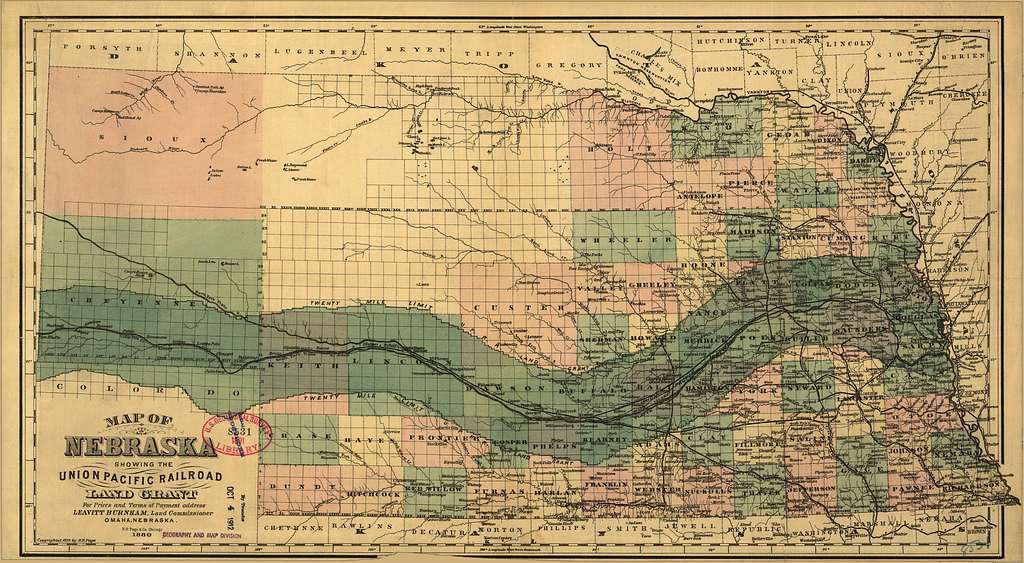OMAHA, Neb. (KMTV) — Laura Ingalls Wilder (when she was born, she was Laura Ingalls, the Wilder part came with marriage) was born in the woods of Wisconsin on Feb. 7, 1867. She was the second of five children, and her family had some blue blood in its veins. When she was two, she moved from Wisconsin to Kansas with her family, looking for new opportunities in the "Great American Desert" as the Central Plains were known. She moved back to Wisconsin until she was seven, then moved to Minnesota, Iowa, and eventually to her semi-permanent settlement in DeSmet, S.D. in 1879. DeSmet is where she would spend much of for formative years, getting married in 1885, finding her first teaching job, and giving birth to her daughter. In 1894, Laura and her family moved to Missouri, where more or less she spent the rest of her life until she died in 1957.

You don't need me to tell you what her biggest accomplishment was, the Little House on the Prairie books. Mostly written in the 1930s and 1940s, the nine-volume work loosely chronicles her upbringing living in many different locations. Today, books are a staple in school reading plans, and the television series of the same name still attracts attention.

Her sixth book in the series is titled The Long Winter, the subject of this installment of This Week in Weather History. In it, Laura writes about the severe winter of 1880-1881 from her perspective in eastern South Dakota. Laura describes fearsome blizzards, brutal colds, the dire situation of a town cut off from the world, and more. This begs the question, was the winter of 1880-1881 that severe across the Midwest? What did it look like? Is there a comparable winter? Did it look the same in Nebraska and Iowa? These questions will be answered in this installment of This Week in Weather History.
THE GREAT PLAINS IN 1880
In 1862, in the midst of the Civil War, President Abraham Lincoln signed into law the Homestead Act. The act stated that anyone who applied was given 160 acres of free land in the western frontier. The passing of the Homestead Act set the conditions for the "Great Dakota Boom" where thousands of people packed up and moved out west from the 1860s through the 1880s.

The Dakota Boom also saw a significant population rise in Nebraska as pioneers sought a better life out in the open prairie. A state since 1867, the population of Nebraska exploded from around 30,000 in 1860; to 122,000 in 1870; to 452,000 in 1880. Omaha saw a similar rise in population, from a town of around 1,000 in 1860 to 30,000 in 1880.
Life on the frontier in Nebraska and Dakota was rough, to say the least. Many settlers lived in sod houses, which did a remarkable job insulating the home during the scorching summer months and brutal winter months. Grass fires often burned wide swaths of prairie. Locusts would swarm, devouring everything in sight. For the pioneers living in Nebraska in 1880, life was brutal, but at least they escaped the plague, filth, and other horrors of the cities.
Perhaps above all else, the weather was like no other in the country. Spring led to severe thunderstorms, giant hail, and tornadoes. Summer was scorching. Autumn brought beneficial rains, sometimes flooding as in spring. However, it was the winters that brought the fury. Temperatures frequently plunged below zero for days in a row, blizzards creating whiteout conditions, among other things. Those who moved to Nebraska in the 1870s experienced firsthand a plains winter in 1880-1881.
WINTER 1880-1881: REALITY VS FICTION

The Long Winter opens its first few chapters with a major blizzard that came unexpectedly in mid-October 1880. This blizzard was seen in the book as unusual as it came so early, and trapped the Ingalls in their home for several days. After a relatively warm and dry November, a blizzard kept the children in the schoolhouse in early December. This blizzard turned into a three-day ordeal where the family pondered the prospects for the winter ahead and worried that the train could not run into town. Afterward, blizzard after blizzard slammed the Midwest through the first few months of 1881. These winter storms continued into March and even April, finally winter relented in early May and brought in warm air.
At least, that's the winter that the book describes. Was it really as bad as Laura remembers? The short answer is yes.
Data for the winter of 1880-1881 is somewhat sparse. We have data from Omaha, Neb., Des Moines, Iowa, Minneapolis/St. Paul, Minn., Fargo, N.D., Aberdeen, S.D., Huron, S.D., and Pierre, S.D. The data gathered at those stations are both temperature and precipitation data, but snowfall data was NOT recorded. We can do rough estimates of snowfall amounts given precipitation data and temperature, but it is not exact. Other sources of information for the winter of 1880 are anecdotal from newspapers, town/county histories, or personal memoirs (like the Little House on the Prairie). With this, we can construct a basic outline of the winter of 1880-1881 for Omaha and the rest of the Midwest.
The winter of 1880-1881 began early with a historic blizzard occurring between Oct. 15 - 18, 1880. Blizzards in October are rare anywhere in the Midwest but are nearly unheard of east of the Rocky Mountains. This blizzard brought wind gusts over 40 mph, several inches of snow, and dropped temperatures very low. In Omaha, the snowfall was less if any at all just cold and wind, but central and northeast Nebraska picked up some snow.

Into November, it began with a mild spell that Laura describes as the "Indian Winter". However, that changed in the middle of the month as temperatures turned sharply colder and never warmed up. In fact, it was so cold in Omaha during November that to this day November 1880 is the coldest November on record.

The cold continued into December with a deep freeze in the first and last weeks of the month, with a small window of warmer temperatures in the middle of the month. Precipitation data shows a stretch of wet weather around Christmas, and given the temperatures below freezing, it likely came down as snow. After Christmas, Omaha experienced a cold period as the new year dawned.

The cold weather continued through January, only a handful of times during the month had Omaha rose above freezing. Repeated snowfall events continued to cripple the region.

Due to the cold weather, the snow hardly melted across the Midwest. Trains stopped running west, stranding many communities such as DeSmet, S.D. for months. As Laura described in her book, people had to rely on their already low food supply to get them through the repeated blizzards and unrelenting cold of the winter months.

It never ended, February was continued cold with repeated snowfalls. In particular, a major blizzard in early February brought Omaha to a standstill for a few days with snowfall over 6" according to the Omaha newspapers.

March continued cold and snowy, even into early April before things finally thawed out by the end of the month.


Into May, spring had come quickly. The feet of snow piled up across the Midwest had to go somewhere, and into the rivers they went. The spring of 1881 proved to be one of the most catastrophic floods in Omaha's history, but that is a story for another time.
THE LONG WINTER IN CONTEXT
The bottom line is that the winter of 1880-1881 was as severe as Laura describes in her book, but where does it fit in the broader context? For that, we can look towards the Accumulated Winter Season Severity Index (AWSSI) to put the winter of 1880-1881 in place with other winters. The AWSSI uses temperature and precipitation data with some math equations to give the winter season a number based on how severe it was. It can be broken up into the temperature and snowfall components, then combined to give a number that can be placed in the context of other winters.

Without going into the nerdy stuff behind it, those interested can read about it here, these are the numbers. In terms of combined AWSSI numbers, the winter of 1880-1881 in Omaha was the second worst winter on record.
Breaking that down into both components. The temperature component for Omaha was scored at 855, which is the maximum AWSSI for temperature. This correlates with the actual data, where each month from October 1880 to April 1881 was running 5-10 degrees below the monthly averages. This culminated in Omaha experiencing the coldest winter on record.

Where the winter score went down is with snowfall, Omaha did not get as much snowfall as those up north did. Using the AWSSI numbers, it was the 12th worst winter in terms of snowfall. Now, this does not equate to the 12th snowiest winter. If we were to guesstimate using our snowiest winters compared with the AWSSI, it is a safe assumption Omaha received between 35-50" of snow during the Winter of 1880-1881, well above average.
These numbers are repeated across the Midwest, with the snowfall amounts exceeding record-high AWSSI numbers in places like Minneapolis. Therefore, it is safe to say the winter of 1880-1881 was the worst winter the Midwest has experienced since record-keeping began in many locations.
SOURCES/FURTHER READING
Much of the research done for this blog post comes from the work done by Barb Mayes Boustead, an Omaha resident whose expertise is in climatology and who has extensively studied the Long Winter of 1880-1881 and its context. She is also the co-creator of the Accumulated Winter Severity Index. Her article about the Long Winter of 1880-1881 can be found here. As can her work on the AWSSI here.
The Long Winter by Laura Ingalls Wilder can be found in most libraries or bookstores, online copies can be located as well.
Another book that looks at the historical context of the Long Winter is The Long, Hard Winter of 1880-1881: What was it Really Like? by Dan L. White. Copies of the book can be purchased online.



